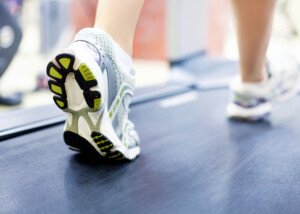
Ever wonder what that fine line is when a walking speed on a treadmill should transition to jogging? Just HOW fast should someone walk on a treadmill?
Walking, either on a treadmill or outdoors, is one of the safest forms of exercise and highly recommended by doctors.
The irony is that the person who’s wondering how fast he or she should walk on a treadmill, might think nothing of ambulating briskly over a long distance at an airport to catch a plane.
Or, they might walk quite fast in an attempt to make a meeting that’s at the other side of the building they work in.
But on a treadmill, suddenly, the idea of brisk walking becomes a concern.
Reassure yourself that walking is as natural as drinking water.
The human body was engineered to walk, including briskly, and including up hills. This is how ancient man survived.
In fact, people did a heck of a lot of walking up to the time that cars were invented.
I honestly cannot think of one medical condition in which this fundamental form of movement can hurt a person, with the exception of orthopedic injuries, and afflictions such as osteoarthritis.
But even people with diabetes neuropathy, peripheral vascular disease and emphysema will benefit tremendously from walking.
So how fast would you like to know you can walk on a treadmill?
- How fast do you normally move in day-to-day life?
- Does brisk ambulation bring on hip or knee pain?
If so, you need to see an orthopedic medical professional. Did you recently sprain an ankle? Limit your walking.
Do you have plantar fasciitis? Same thing during flare-ups: Limit walking.
If your joints are fine and you have no injuries, then exercise away. If you feel dizzy during your session, get off the machine.
It’s possible your blood sugar is low, or that you may even be pregnant.
It’s also possible your body just isn’t used to walking on a moving belt.
Do not hold onto the machine, as this will not solve the underlying issue.
If this popular exercise brings on nausea or dizziness, stop and re-evaluate your eating habits and water intake.
Medications can also cause these side effects. If you’re pregnant, treadmill use is perfectly safe to do as long as you feel fine. Talk to your OB/GYN about that.
What’s most important is not how fast you should move on a treadmill, but your form.
You absolutely should not cling onto the machine when walking. Here are 10 reasons never to hold onto a treadmill.
Walk fast enough on a treadmill to get the heart rate up.
Swing arms and focus on good posture and breathing.
• Don’t slam your feet.
• Relax and let your body fall into its natural stride.
• If walking fast on a treadmill fails to get your heart rate up much, then either add an incline (but not so much that you’re forced to hold on), or transition to jogging.
• Don’t obsess about heart rate, and when you do take it, it’s more accurate to take it via feeling for your pulse while at rest, rather than assuming that the machine’s interpretation is correct.
Put a challenge on yourself: Train to work up to maintaining a 4 mph pace on a treadmill — without holding on.
That’s a pretty fast clip, but at the gym where I had worked as a personal trainer, I always saw a man, age 72, spend an entire hour walking 4 mph — without holding on!

























